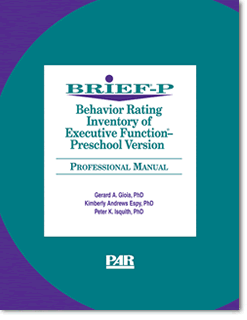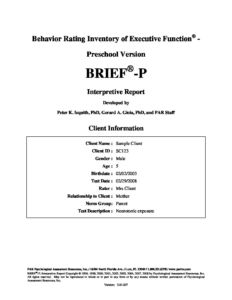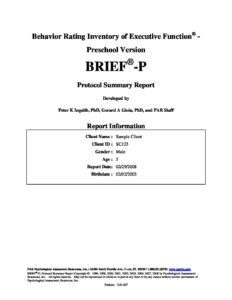
Behaviour Rating Inventory of Executive Function - Preschool Version brief-p
For: Assess executive functioning in preschool-aged children
Age range: 2 years to 5 years, 11 months
Reading Level: Preschool - Child
Format: Paper and Pencil
Length: 10-15 minutes
Scoring: Hand Scored, Computer Scored or Online (via PARiConnect)
Online Forms, Reports, Kits & e-Manuals
Click to browse products
Printed Manuals
Click to browse products
Printed Forms & Handscoring Materials
Test forms, response booklets and scoring reference manuals.
Printed Kits
Click to browse products
BRIEF-P e-Manual
BRIEF-P online Interpretive Report (each) min order 5
BRIEF-P online Score Report (each) min order 5
BRIEF-P online i-Admin (each) min order 5
BRIEF-P Manual
BRIEF-P Rating Forms (25)
BRIEF-P Scoring/Profile Forms (25)
BRIEF-P Kit
Related Products
BRIEF 2
BRIEF-A
BRIEF-A-SP
BRIEF-P-SP
Contact PAA today to set up your PARiConnect online account to utilise online administration, scoring and reporting.
Authors
Gerard A. Gilia, PhD, Kimberly Andres Espy, PhD, Peter K. Isquith, PhD
Description
The observations of parents and teachers provide a wealth of information about a child’s behaviour that is directly relevant to an understanding of that child’s executive functioning. The assessment of executive function in preschool-aged children is often difficult because of the variable nature of behaviour in this age range (ages 2.0-5.11 years); the limitations in motor and verbal proficiency at this age; and the many neuropsychological, psychological, developmental, and other medical conditions that begin to manifest during the preschool years.
The BRIEF-P is the first standardised rating scale designed to specifically measure the range of behavioural manifestations of executive function in preschool-aged children – thus facilitating intervention at earlier stages of development.
The BRIEF-P consists of a single Rating Form used by parents, teachers, and day care providers to rate a child’s executive functions within the context of his/her everyday environments – home and preschool. The original Behaviour Rating Inventory of Executive Function (BRIEF) was the basis for the development of the BRIEF-P. Consequently, the BRIEF-P is an ecologically valid and efficient tool for screening, assessing, and monitoring a young child’s executive functioning and development.
The hand scorable BRIEF-P Rating Form consists of 63 items that measure various aspects of executive functioning: Inhibit, Shift, Emotional Control, Working Memory, and Plan/Organise. The clinical scales form three broad indexes (Inhibitory Self-Control, Flexibility and Emergent Metacognition) and one composite score (Global Executive Composite). The BRIEF-P also provides two validity scales (Inconsistency and Negativity).
High internal consistency reliability (.80-.95 for parent sample and .90-.97 for teacher sample); test-retest reliability (.78-.90 for parents and .64-.94 for teachers); and modest correlations between parent and teacher ratings (.14-.28).
Convergent and discriminant validity was demonstrated with other measures of inattention, hyperactivity-impulsivity, depression, atypicality, anxiety and somatic complaints (i.e., ADHD Rating Scale-IV, Preschool Version; Child Behaviour Checklist/1.5-5; Behaviour Assessment System for Children-Parent Rating Scale).
Factor analytic studies provide support for the three-factor model of executive functioning as embodied by the three indexes, which accounted for 87% and 92% of the variance in the parent and teacher normative groups, respectively. The Working Memory and the Plan/Organize scales define the first component; the Shift and Emotional Control scales define the second component; and the Inhibit and Emotional Control scales define the third component.
Normative data is based on child ratings from 460 parents and 302 teachers from urban, suburban, and rural areas, reflecting 1999 U.S. Census estimates for race/ethnicity, gender, socio-economic status and age.
Clinical samples included children in the following diagnostic/clinical groups: ADHD, prematurity, language disorders, autism spectrum disorders and mixed clinical.
The BRIEF-P is useful in assessing preschool-aged children with such medical, acquired neurological, and developmental conditions as prematurity, emerging learning disabilities and attentional disorders, language disorders, traumatic brain injuries, lead exposure, and pervasive developmental disorders/autism.
BRIEF-P-Software Portfolio
The BRIEF-P SP is used to score and generate reports for the BRIEF-P exclusively. After hand-entry of an individual’s item or scale raw scores, the program generates normative scores for Interpretive Reports, Feedback Reports and Protocol Summary Reports. The comprehensive Interpretive Report saves valuable clinician report-writing time, and the Feedback Report, written with the client’s family, teacher, and/or care provider in mind, provides a basic overview of the client’s BRIEF-P test results.
NB: Prices are in Australian dollars inclusive of GST. NZ customers need to log in to view ex-GST prices.





